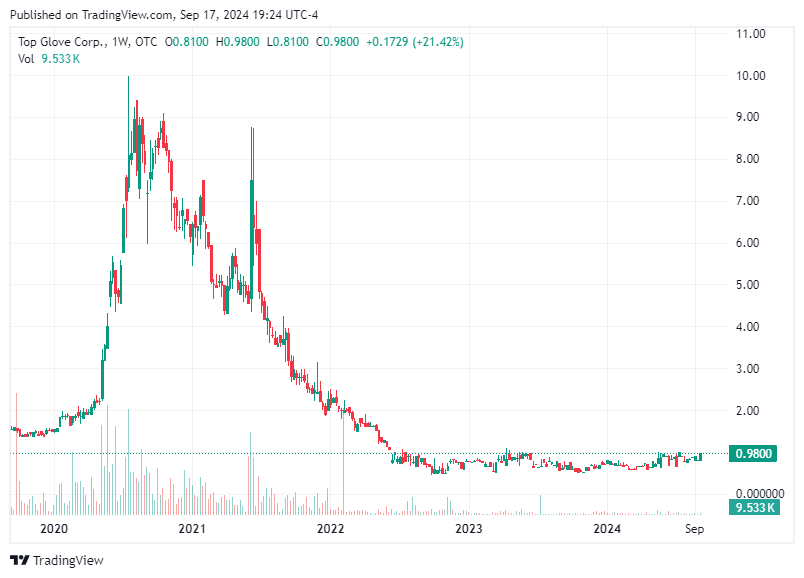Malaysian Glove Maker's Stock Surges Amid U.S. Tariffs On China
Malaysian Glove Stocks Surge Amid U.S. Tariffs on Chinese Competitors.

Disclaimer: The following article is intended for informational purposes only and should not be considered as financial or investment advice. The content herein aims to provide an overview of recent developments in the Malaysian glove industry in light of international trade policies. Readers are encouraged to perform their own research and consult with financial professionals before making any investment decisions.
We are working endlessly to provide free insights on the stock market every day, and greatly appreciate those who are paid members supporting the development of the Stock Region mobile application. Stock Region offers daily stock and option signals, watchlists, earnings reports, technical and fundamental analysis reports, virtual meetings, learning opportunities, analyst upgrades and downgrades, catalyst reports, in-person events, and access to our private network of investors for paid members as an addition to being an early investor in Stock Region. We recommend all readers to urgently activate their membership before reaching full member capacity (500) to be eligible for the upcoming revenue distribution program. Memberships now available at https://stockregion.net
In recent months, the landscape of the global glove industry has witnessed a significant shift, particularly affecting Southeast Asian producers. This transformation has been markedly driven by the United States' decision to impose heightened tariffs on Chinese-made gloves, thereby providing a potential boon for Malaysian manufacturers.
The Tariff Announcement and Its Immediate Impact
The U.S. administration, under President Joe Biden, recently announced a series of tariffs impacting various Chinese goods, including medical gloves. These tariffs are set to increase to 50% by 2025 and double to 100% by 2026. This move is part of a broader strategy to reduce dependency on Chinese products and bolster other Asian markets, particularly in Southeast Asia.
The immediate aftermath of this announcement was seen in the Malaysian stock market, where shares of major glove manufacturers such as Top Glove Corp and Hartalega Holdings Bhd surged. Top Glove experienced a record increase of up to 32%, while Hartalega hit a 30% rally limit. This surge is reminiscent of the pandemic-driven boom of 2020 when there was an unprecedented global demand for medical gloves. Malaysia has long been a dominant player in the global glove industry, often cited as the world's largest producer of gloves. The industry's roots can be traced back to the late 20th century, when Malaysia capitalized on its natural rubber resources to manufacture latex gloves, which were in high demand across healthcare sectors worldwide.
The demand for gloves skyrocketed during the COVID-19 pandemic, as countries scrambled to secure personal protective equipment for healthcare workers. This led to a massive increase in production and a corresponding rise in stock values for companies like Top Glove, Hartalega, Kossan Rubber Industries, and Supermax Corp. However, as the pandemic subsided, demand stabilized, leading to a normalization of stock prices.
The Strategic Shift: U.S. Tariffs and Market Dynamics
The recently announced U.S. tariffs are expected to recalibrate market dynamics once again. Analysts suggest that Malaysian glove manufacturers will benefit from reduced competition from Chinese counterparts, potentially reclaiming market share lost in the post-pandemic period. This development provides an opportunity for Malaysian producers to leverage their established infrastructure and experience in glove manufacturing.
The tariff decision is also timely for Malaysian producers, as it coincides with a period of moderated demand post-pandemic. With the potential reduction of Chinese market share, Malaysian companies can optimize their production capacities and improve profit margins. This scenario may lead to a revitalization of investor interest in the Malaysian glove sector, akin to the fervor seen in 2020. Investor sentiment towards Southeast Asian equities, particularly Malaysian glove stocks, has been buoyant since the tariff announcement. Brokers and analysts have responded positively, with multiple upgrading their outlook on prominent Malaysian manufacturers. This optimism is not just confined to Malaysian markets but extends to regional peers in Thailand and other Southeast Asian countries, which are also expected to benefit from the shift in trade dynamics.
The positive market reaction is further showcased by the broader economic context, where Southeast Asia is seen as a potential beneficiary of a predicted pivot in U.S. Federal Reserve interest rates. Four of the five best-performing Asian stock benchmarks for the month were from this region, signaling robust investment inflows and confidence in future growth prospects.
Global Market Outlook
The long-term implications of the U.S. tariffs on Chinese gloves extend beyond immediate market gains for Malaysian producers. It highlights a strategic realignment in global trade policies, where countries are increasingly looking to diversify their supply chains and reduce reliance on single-source providers like China.
For Malaysian glove manufacturers, the tariffs present an opportunity to enhance their competitiveness and innovation in the industry. Companies may invest in advanced technologies and sustainable practices to maintain their edge in a market that is becoming increasingly conscious of environmental and ethical standards. Investors, on the other hand, must remain vigilant to the evolving geopolitical and economic landscape. While the current environment appears favorable for Malaysian glove stocks, the global market is inherently volatile, and shifts in international relations and economic policies can alter the playing field rapidly.
The recent surge in Malaysian glove stocks, fueled by U.S. tariffs on Chinese competitors, is a testament to the dynamic nature of global trade and industry. As Malaysian manufacturers stand to benefit from this policy shift, the broader implications for the global market and investors remain profound. Understanding the historical context, current market dynamics, and potential future developments is crucial for stakeholders navigating this complex landscape.
Disclaimer: This article is intended solely for informational purposes. It does not constitute financial advice or a recommendation for investment. Readers should conduct their own research and consult with financial professionals before making any decisions related to investments or economic strategies.


